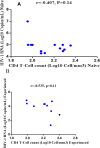Sero-prevalence of cryptococcal antigen and its immune-virological correlates in HIV-1 positive individuals: a prospective cross-sectional study
- PMID: 40181424
- PMCID: PMC11966920
- DOI: 10.1186/s12981-025-00738-4
Sero-prevalence of cryptococcal antigen and its immune-virological correlates in HIV-1 positive individuals: a prospective cross-sectional study
Abstract
Background: Cryptococcal infection remains a leading cause of mortality among HIV-1-positive individuals, particularly in regions with limited access to antiretroviral therapy and diagnostics. This study aimed to assess Cryptococcal Antigen (CrAg) seroprevalence and its immune-virological correlates among ART-naïve and ART-experienced HIV-1 positive individuals.
Methods: This prospective cross-sectional study was conducted from May 2023 to August 2024 at Edo State University Teaching Hospital, Nigeria. Blood samples were analyzed for CD4 + T-cell counts using a Partec™ CyFlow analyzer, HIV-1 viral load using the COBAS® AmpliPrep/COBAS® TaqMan® Test, and CrAg detection with the Immy Latex-Crypto Antigen Lateral Flow Assay.
Results: Among 229 HIV-1 positive individuals, 72.5% were aged 15-20 years, and 69% were female. Most (68.6%) were ART-experienced, while 31.4% were ART-naïve. Severe immunosuppression (CD4 + < 200 cells/mm³) was present in 64.6%, and 71.2% had viral loads > 1,000 copies/mL. Cryptococcal infection (CI) prevalence was 10.04%. No significant link was found between CI and age or gender, but ART-naïve status, low CD4 + counts, and high viral loads were significantly associated with CI. ART-naïve individuals had higher viral loads (median 4.95 vs. 4.19 log10 copies/mL, p = 0.00). A stronger inverse correlation between CD4 + counts and viral load was observed in ART-experienced patients (r = -0.535).
Conclusions: These findings emphasize the necessity for routine Cryptococcal screening, particularly in ART-naïve and severely immunocompromised individuals, to facilitate timely interventions and improve clinical outcomes.
Keywords: ART; CD4 + T-cell counts; Cryptococcal antigen; HIV-1; Immune-Virological correlates; Sero-Prevalence; Viral load.
© 2025. The Author(s).
Conflict of interest statement
Declarations. Ethics approval and consent to participate: The study protocol was approved by the hospital research ethics committee of Edo State University, Uzarue, Nigeria (ethical approval number: EDSUREC23/0074). Informed consent was obtained from all the participants in accordance with Helsinki Declaration of 1975, as revised in 2000; voluntariness and strict confidentiality were maintained throughout the study. Consent for publication: Not applicable. Competing interests: The authors declare no competing interests. Clinical trial: Not applicable.
Figures


Similar articles
-
Cryptococcal antigenemia in anti-retroviral naïve AIDS patients: prevalence and its association with CD4 cell count.Acta Med Iran. 2012;50(5):344-7. Acta Med Iran. 2012. PMID: 22837089
-
Cryptococcal antigenemia and associated risk factors among ART-naïve and ART-experienced HIV-infected peoples at selected health institutions of Mekelle, Northern Ethiopia.Microbiologyopen. 2019 Jun;8(6):e00746. doi: 10.1002/mbo3.746. Epub 2018 Oct 2. Microbiologyopen. 2019. PMID: 30277315 Free PMC article.
-
Factors associated with cryptococcal capsular antigen positivity among people living with HIV: a retrospective observational cohort study.BMC Infect Dis. 2025 Aug 13;25(1):1014. doi: 10.1186/s12879-025-11417-0. BMC Infect Dis. 2025. PMID: 40804366 Free PMC article.
-
CD4 Cell Count Threshold for Cryptococcal Antigen Screening of HIV-Infected Individuals: A Systematic Review and Meta-analysis.Clin Infect Dis. 2018 Mar 4;66(suppl_2):S152-S159. doi: 10.1093/cid/cix1143. Clin Infect Dis. 2018. PMID: 29514236 Free PMC article.
-
LATERAL FLOW ASSAY FOR CRYPTOCOCCAL ANTIGEN: AN IMPORTANT ADVANCE TO IMPROVE THE CONTINUUM OF HIV CARE AND REDUCE CRYPTOCOCCAL MENINGITIS-RELATED MORTALITY.Rev Inst Med Trop Sao Paulo. 2015 Sep;57 Suppl 19(Suppl 19):38-45. doi: 10.1590/S0036-46652015000700008. Rev Inst Med Trop Sao Paulo. 2015. PMID: 26465368 Free PMC article. Review.
References
-
- Eric E, Olupot-Olupot P, Bwayo D, Meya D, Katuramu R. Prevalence and factors associated with Cryptococcal antigenemia among patients with advanced human immunodeficiency virus in Eastern Uganda: A facility-based cross-sectional study. Open Forum Infect Dis. 2023;10(7). 10.1093/ofid/ofad351. - PMC - PubMed
MeSH terms
Substances
LinkOut - more resources
Full Text Sources
Medical
Research Materials

